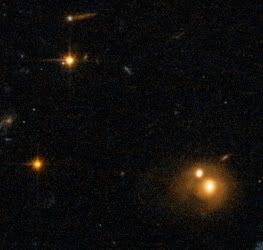Page 1 of 1
Coma Cluster picture (APOD 16 Jun 2008)
Posted: Mon Jun 16, 2008 6:11 am
by Dennis Ross
In the high resolution picture, I printer the upper left corner. 13 cm from the left edge and 5 cm from the top there is a edge on view of a galaxie with a bright point of light in the left end of the galaxie.
Is this possibly a super nova?
Reply to
d_ross@oh.rr.com
Thank you.
Dennis Ross
Posted: Mon Jun 16, 2008 9:34 am
by harry
Hello Dennis
Re:
Inside the Coma Cluster of Galaxies
http://antwrp.gsfc.nasa.gov/apod/ap080616.html
I had a look at the image,,,,,,,130mm from left and 50 mm from top.
I cannot see the image is question.
Posted: Mon Jun 16, 2008 1:51 pm
by BMAONE23
With the screen resolution set at 1024 x 768 pixels, I believe the galaxy in question is in the bottom right corner of the screen when the image is at full resolution and not reduced. It is near the first Orange galaxy of notable size near the upper left corner of the image. Near to the orange galaxy that appears to have a dual core. Kind of resembles a comet with an orange tail.
Posted: Mon Jun 16, 2008 2:44 pm
by bystander
Re: Coma Cluster picture on June 16
Posted: Mon Jun 16, 2008 4:50 pm
by Case
If Dennis was looking at this one:

then that may be a
merger happening, judging by the shape of soft glow, which may be distorted
arms or distorted
lenticular disk.
Posted: Mon Jun 16, 2008 5:12 pm
by BMAONE23
I believe it is just above and left of that merger, slightly outside of the upper left corner of this particular image field.
I believe it lies abbout 1/3 of the way between this merger and the bright blue/white spiral 45deg NE at the top of the image. Resembles a white comet with an orange tail

Posted: Mon Jun 16, 2008 5:36 pm
by Sputnick
Yup .. I see it. Did anyone see he Smiley smile just below and to the left of centre? Several galaxies in an obvious curve .. looks like a gravity lens or the edge of a time funnel, with the group of galaxies (small and far away) at the centre of the picture providing the lens or funnel.
So many stars .. so many space people of various shapes, colours, etc. I hope they aren't as screwed up as this planet's population.
Re: Coma Cluster picture on June 16
Posted: Mon Jun 16, 2008 6:56 pm
by iamlucky13
Case wrote:If Dennis was looking at this one:

then that may be a
merger happening, judging by the shape of soft glow, which may be distorted
arms or distorted
lenticular disk.
I agree. Additionally, supernova aren't overwhelmingly bright in the visible/infrared light portion of the spectrum, so I'm sure it's unlikely that we'd see one so easily compared to the billions of stars in the parent galaxy.
Posted: Wed Jun 18, 2008 9:05 am
by harry
G'day all
Thank you for the directions.
I have several options
1) Its an overlap of one elliptical galaxy over the other with a distance between them, not affecting their structure.
2) Its an elliptical galaxy with two main black holes.
3) That it maybe a hypernova
Re: Coma Cluster picture on June 16
Posted: Wed Jun 18, 2008 4:26 pm
by Qev
iamlucky13 wrote:I agree. Additionally, supernova aren't overwhelmingly bright in the visible/infrared light portion of the spectrum, so I'm sure it's unlikely that we'd see one so easily compared to the billions of stars in the parent galaxy.
I was under the impression that supernovae often outshone their host galaxies in visible light. Though in the image Case was pointing out, I agree, it looks like a pair of merging galaxies.
Posted: Wed Jun 18, 2008 5:06 pm
by BMAONE23
I think that the original question is refering to the edge on galaxy in the upper right of this image crop

I believe this is the galaxy referred to in the original question

Re: Coma Cluster picture on June 16
Posted: Wed Jun 18, 2008 6:37 pm
by iamlucky13
Qev wrote:iamlucky13 wrote:I agree. Additionally, supernova aren't overwhelmingly bright in the visible/infrared light portion of the spectrum, so I'm sure it's unlikely that we'd see one so easily compared to the billions of stars in the parent galaxy.
I was under the impression that supernovae often outshone their host galaxies in visible light. Though in the image Case was pointing out, I agree, it looks like a pair of merging galaxies.
Yes, they often outshine their host galaxies, but they're brightest in gamma rays. Most of the visible light they produce is the afterglow as the gamma rays heat surrounding gas and dust. It is produced much more gradually, so the peak intensity in those wavelengths is lower.
I'm having a hard time finding a good clarification to that trivia about them being brighter than their galaxies. I've found several spectra, but they all seem to be apparent magnitude and not fully labeled, so it's hard to figure out.
Of course, throughout history there have been a few plainly visible in the sky, but all those were within the Milky Way.
Posted: Thu Jun 19, 2008 6:17 am
by harry
Hello All
The more I think of the image, the more I think it is two elliptical galaxies at a distance apart.
Posted: Thu Jun 19, 2008 8:31 pm
by dreamer84
is this

coincidence or an image error? the two brown galaxies look just like the two orange ones enlarged...



